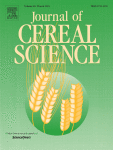View Item
- xmlui.general.dspace_homeCentros Regionales y EEAsCentro Regional Buenos Aires NorteEEA PergaminoArtículos científicosxmlui.ArtifactBrowser.ItemViewer.trail
- DSpace Home
- Centros Regionales y EEAs
- Centro Regional Buenos Aires Norte
- EEA Pergamino
- Artículos científicos
- View Item
Discriminating post-silking environmental effects on starch composition in maize kernels
Abstract
Maize (Zea mays L.) endosperms with high amylose proportion are harder and denser than endosperms with low amylose. Environmental conditions could affect amylose/starch ratio. The purpose of this work was to prove the effect of incident solar radiation, temperature, refertilization with nitrogen (N) and sulfur (S) and source/sink ratio during grain filling on maize amylose/starch ratio. The associations among changes in amylose/starch ratio and other
[ver mas...]
Maize (Zea mays L.) endosperms with high amylose proportion are harder and denser than endosperms with low amylose. Environmental conditions could affect amylose/starch ratio. The purpose of this work was to prove the effect of incident solar radiation, temperature, refertilization with nitrogen (N) and sulfur (S) and source/sink ratio during grain filling on maize amylose/starch ratio. The associations among changes in amylose/starch ratio and other grain components were also analyzed. We evaluated shading treatments in two periods during grain filling period. Fertilization treatments were evaluated by adding extra N and S per hectare in V15. Heating treatments were evaluated by increasing surface grain temperature during the grain filling period. Source/sink ratio was modified via defoliation and plant thinning. Variations in source/sink ratio or refertilization with N and S did not produce significant changes in starch composition. Increases in minimum temperature during early effective grain filling were related to decreases in starch percentage and to increases in amylose/starch ratio. Thus, future maize starch quality studies need to focus on thermal conditions during grain filling and on the metabolic steps involved. According to these results, management practices that imply a modification in temperature during the grain filling period affect starch composition.
[Cerrar]

Author
Martínez, Roberto D.;
Cirilo, Alfredo Gabriel;
Cerrudo, Aníbal Alejandro;
Andrade, Fernando Hector;
Izquierdo, Natalia Gabriela;
Fuente
Journal of Cereal Science 87 : 150-156 (May 2019)
Date
2019-05
Editorial
Elsevier
ISSN
0733-5210
Formato
pdf
Tipo de documento
artículo
Palabras Claves
Derechos de acceso
Restringido
 Excepto donde se diga explicitamente, este item se publica bajo la siguiente descripción: Creative Commons Attribution-NonCommercial-ShareAlike 2.5 Unported (CC BY-NC-SA 2.5)
Excepto donde se diga explicitamente, este item se publica bajo la siguiente descripción: Creative Commons Attribution-NonCommercial-ShareAlike 2.5 Unported (CC BY-NC-SA 2.5)

